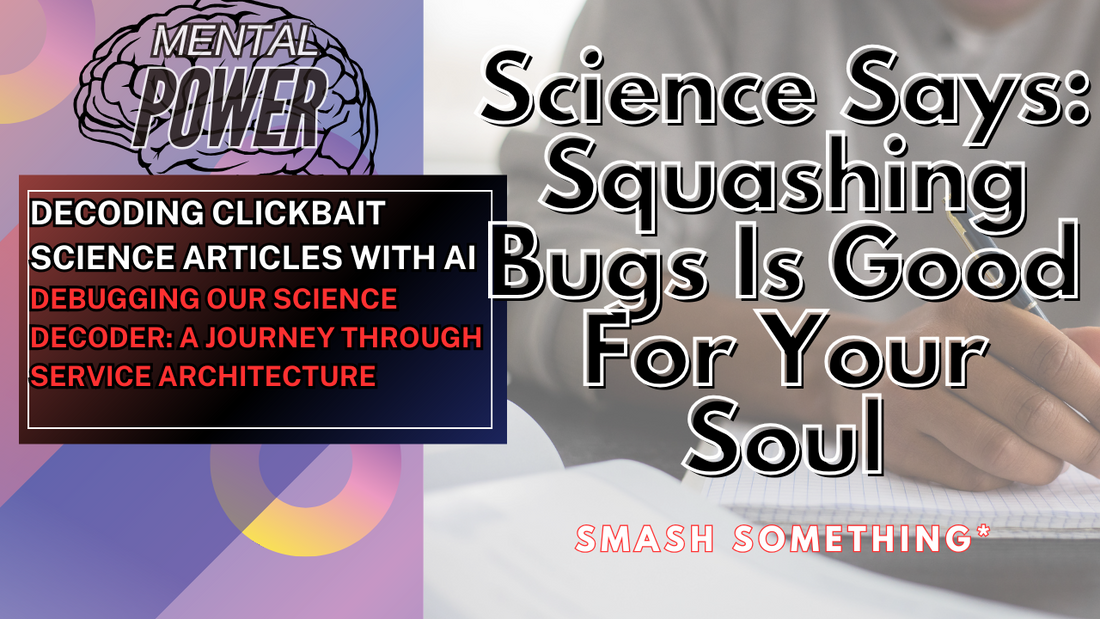Hey there! In our last post, we started building a tool to help people understand scientific articles better. Today, we ran into some bugs, and I want to walk you through how we found and fixed them. This is the kind of problem-solving that employers love to see!
The Problem We Found
When we tried to search for articles about "exercise brain health", our app showed this error:
{"detail":"'ScientificStudyService' object has no attribute 'collection'"}
The computer is telling me "You're trying to open a door (collection) that doesn't exist.". We told our app to look for something behind a door labeled 'collection', but we never created that door! Yes, that's a problem. (how do we prevent this from happening?)
Why This Matters
This kind of bug might seem small, but it's super important to fix because:
- Users can't search for scientific articles (that's the main point of our app!)
- The error message isn't helpful to users
- It shows us we need to be more careful about how we organize our code
Looking at Our Code Structure
Our app has several main parts:
- BaseService: The foundation that all our other services build on
- ScientificStudyService: Handles scientific papers
- ArticleService: Manages news articles and blog posts
- SearchService: Helps find content across the entire app
- DatabaseManager: Keeps track of all our data
It's like a library where:
- BaseService is the main desk where all basic tasks happen
- ScientificStudyService is the reference section
- ArticleService is the news section
- SearchService is the card catalog
- DatabaseManager is the system that keeps track of where every book is stored
What Went Wrong
We found three main problems:
-
Wrong Names: We were using
self.collectionwhen we should have usedself.collection_name - Missing Setup: Some services weren't properly connected to their database collections
- Unclear Error Messages: Our error handling didn't explain problems in a helpful way
How We Fixed It
Let's look at each fix:
-
Using the Right Names ```python
Before (wrong):
async def get_collection(self): return await database.get_collection(self.collection)
After (correct):
async def get_collection(self): return await database.get_collection(self.collection_name)
2. **Better Service Setup**
```python
# Before (missing initialization):
class ScientificStudyService(BaseService[ScientificStudy]):
def __init__(self):
super().__init__(Collection.SCIENTIFIC_STUDIES, ScientificStudy)
# After (complete initialization):
class ScientificStudyService(BaseService[ScientificStudy]):
def __init__(self):
super().__init__(Collection.SCIENTIFIC_STUDIES, ScientificStudy)
self.collection_name = Collection.SCIENTIFIC_STUDIES
-
Helpful Error Messages ```python
Before:
except Exception as e: raise
After:
except Exception as e: logger.error(f"Failed to search studies: {str(e)}") raise HTTPException( status_code=500, detail="Could not complete search. Please try again." )
## Testing Our Fix
We created tests to make sure everything works:
```python
@pytest.mark.asyncio
async def test_search_similar_studies():
service = ScientificStudyService()
results = await service.search_similar_studies(
query_text="exercise brain health",
limit=5,
min_score=0.5
)
assert len(results) > 0
Why This Matters for Your Business
If you're a hiring manager or looking to build something similar, this kind of debugging shows:
- Attention to Detail: We catch and fix problems before users see them
- User Focus: We make error messages helpful and clear
- Code Quality: We write tests to prevent future problems
- Maintainability: Our code is organized and easy to update
What's Next?
In our next post, we'll add some cool features:
- Better search results
- More detailed article analysis
- User feedback on search results
Want to try this yourself? Here's what you can do:
- Clone our repository
- Follow our setup instructions
- Try searching for different topics
- Let us know what you think!
Technical Details for Developers
For the technically minded, here's what we changed:
- Updated service initialization to properly handle collections
- Added type checking for better code safety
- Improved error handling with detailed logging
- Added comprehensive tests for each service
Remember: Good error handling isn't just about fixing bugs - it's about making your app more trustworthy and easier to use!
Next time, we'll look at how to make our search results even better. Stay tuned!
Did you miss the beginning of the Science Clickbait Decoder blog series? Read Part 1 HERE. We tell the story about why we're building the tool.
Read Part 2 Step 1 HERE. Part 2 Step 1 is when the coding starts.
Read Step 2 HERE. In Step 2 we create the FastAPI, add HuggingFace's SciBERT Model, and connect the backend to FAISS.
Read Step 3 HERE. In Step 3 we add a MongoDB on Cloud Atlas to store data and setup a local MongoDB instance for back.
Read Step 4 HERE. In Step 4 we create separate collections for Scientific Studies and Articles.
Excited about what’s coming? Share your progress so far and stay tuned for what's next.
If you have any questions or need help, feel free to ask. You may reach me by leaving a comment or clicking the chat bubble in the bottom right corner of the screen.
Contact
For questions or inquiries, reach out at a@awews.com. Chat with Brand Anthony McDonald in real-time by visiting https://i.brandanthonymcdonald.com/portfolio ``` Text "CENT" to 833.752.8102 to join me on my journey to becoming the world's fastest centenarian.
Made with ❤️ by BAM
